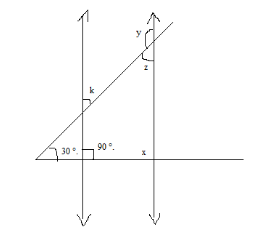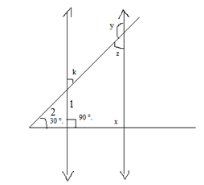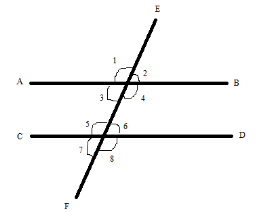
In the given figures, the directed lines are parallel to each other. Find the unknown angles.


Answer
556.2k+ views
Hint: Here we will use the property of two parallel lines which states that if two lines are parallel and cut by a transversal then the pair of corresponding angles, interior angles, and exterior angles are equal. Also, interior angles on the same side of the transversal are supplementary.
Complete step-by-step solution:
Step 1: In the below figure, angle \[x\] and
\[\angle 1\] are co-interior angles. So, as per the property of parallel lines the sum of these two angles will be equals to \[{180^\circ}\] as shown below:

\[\angle x + \angle 1 = {180^\circ}\]
By substituting the value of \[\angle 1 = {90^\circ}\] (as given) in the above equation, we get:
\[ \Rightarrow \angle x + {90^\circ} = {180^\circ}\]
By bringing
\[{90^\circ}\] into the RHS side of the equation and subtracting it from \[{180^\circ}\] we get:
\[ \Rightarrow \angle x = {90^\circ}\]
Step 2: Now, angle
\[x\],
\[\angle 2\] and \[z\] are three angles of the triangle. And we know that the sum of the angle of the triangle is
\[{180^\circ}\]. So, we can write the equation as below:
\[ \Rightarrow \angle x + \angle z + \angle 2 = {180^\circ}\]
By substituting the values of
\[\angle x = {90^\circ}\] and \[\angle 2 = {30^\circ}\] (as given) in the above equation we get:
\[ \Rightarrow {90^\circ} + \angle z + {30^\circ} = {180^\circ}\]
After adding the angles in the LHS side of the above equation, we get:
\[ \Rightarrow {120^\circ} + \angle z = {180^\circ}\]
By bringing
\[{120^\circ}\] into the RHS side of the equation and subtracting it from \[{180^\circ}\] we get:
\[ \Rightarrow \angle z = {60^\circ}\]
Step 3: Now, we know that any sum of the angles in any straight line always equals to
\[{180^\circ}\] , by using this property we can write the below equation:
\[ \Rightarrow \angle y + \angle z = {180^\circ}\]
By substituting the value of \[\angle z\] in the above equation we get:
\[ \Rightarrow \angle y + {60^\circ} = {180^\circ}\]
Bringing
\[{60^\circ}\] into the RHS side of the equation and subtracting it from \[{180^\circ}\] we get:
\[ \Rightarrow \angle y = {120^\circ}\]
Step 4: Angle
\[k\] and \[y\] are co-interior angles. So, as per the property of parallel lines the sum of these two angles will be equals to
\[{180^\circ}\] as shown below:
\[ \Rightarrow \angle y + \angle k = {180^\circ}\]
By substituting the value of
\[\angle y\] in the above equation we get:
\[ \Rightarrow \angle k + {120^\circ} = {180^\circ}\]
Bringing
\[{120^\circ}\] into the RHS side of the equation and subtracting it from \[{180^\circ}\] we get:
\[ \Rightarrow \angle k = {60^\circ}\]
The value of all unknown angles are \[\angle k = {60^\circ}\],
\[\angle y = {120^\circ}\],\[\angle z = {60^\circ}\] and \[\angle x = {90^\circ}\].
Note: Students need to remember the property of parallel lines while calculating the angles made by the transversal line which cuts the two parallel lines. For example:

\[{\text{AB}}\] and \[{\text{CD}}\] are two parallel lines cuts by a transversal line \[{\text{EF}}\]than below are the important points to remember:
Interior and exterior alternate angles are equal. i.e. \[\angle 3 = \angle 6\], \[\angle 4 = \angle 5\](Interior angles)
\[\angle 1 = \angle 8\] and
\[\angle 2 = \angle 7\](exterior angles)
Corresponding angles of the lines are equal, i.e. \[\angle 2 = \angle 6\], \[\angle 1 = \angle 5\], \[\angle 3 = \angle 7\] and \[\angle 4 = \angle 8\]
Co-interior angles are supplementary, i.e. \[\angle 3 + \angle 5 = {180^\circ}\] and \[\angle 4 + \angle 6 = {180^\circ}\].
Complete step-by-step solution:
Step 1: In the below figure, angle \[x\] and
\[\angle 1\] are co-interior angles. So, as per the property of parallel lines the sum of these two angles will be equals to \[{180^\circ}\] as shown below:

\[\angle x + \angle 1 = {180^\circ}\]
By substituting the value of \[\angle 1 = {90^\circ}\] (as given) in the above equation, we get:
\[ \Rightarrow \angle x + {90^\circ} = {180^\circ}\]
By bringing
\[{90^\circ}\] into the RHS side of the equation and subtracting it from \[{180^\circ}\] we get:
\[ \Rightarrow \angle x = {90^\circ}\]
Step 2: Now, angle
\[x\],
\[\angle 2\] and \[z\] are three angles of the triangle. And we know that the sum of the angle of the triangle is
\[{180^\circ}\]. So, we can write the equation as below:
\[ \Rightarrow \angle x + \angle z + \angle 2 = {180^\circ}\]
By substituting the values of
\[\angle x = {90^\circ}\] and \[\angle 2 = {30^\circ}\] (as given) in the above equation we get:
\[ \Rightarrow {90^\circ} + \angle z + {30^\circ} = {180^\circ}\]
After adding the angles in the LHS side of the above equation, we get:
\[ \Rightarrow {120^\circ} + \angle z = {180^\circ}\]
By bringing
\[{120^\circ}\] into the RHS side of the equation and subtracting it from \[{180^\circ}\] we get:
\[ \Rightarrow \angle z = {60^\circ}\]
Step 3: Now, we know that any sum of the angles in any straight line always equals to
\[{180^\circ}\] , by using this property we can write the below equation:
\[ \Rightarrow \angle y + \angle z = {180^\circ}\]
By substituting the value of \[\angle z\] in the above equation we get:
\[ \Rightarrow \angle y + {60^\circ} = {180^\circ}\]
Bringing
\[{60^\circ}\] into the RHS side of the equation and subtracting it from \[{180^\circ}\] we get:
\[ \Rightarrow \angle y = {120^\circ}\]
Step 4: Angle
\[k\] and \[y\] are co-interior angles. So, as per the property of parallel lines the sum of these two angles will be equals to
\[{180^\circ}\] as shown below:
\[ \Rightarrow \angle y + \angle k = {180^\circ}\]
By substituting the value of
\[\angle y\] in the above equation we get:
\[ \Rightarrow \angle k + {120^\circ} = {180^\circ}\]
Bringing
\[{120^\circ}\] into the RHS side of the equation and subtracting it from \[{180^\circ}\] we get:
\[ \Rightarrow \angle k = {60^\circ}\]
The value of all unknown angles are \[\angle k = {60^\circ}\],
\[\angle y = {120^\circ}\],\[\angle z = {60^\circ}\] and \[\angle x = {90^\circ}\].
Note: Students need to remember the property of parallel lines while calculating the angles made by the transversal line which cuts the two parallel lines. For example:

\[{\text{AB}}\] and \[{\text{CD}}\] are two parallel lines cuts by a transversal line \[{\text{EF}}\]than below are the important points to remember:
Interior and exterior alternate angles are equal. i.e. \[\angle 3 = \angle 6\], \[\angle 4 = \angle 5\](Interior angles)
\[\angle 1 = \angle 8\] and
\[\angle 2 = \angle 7\](exterior angles)
Corresponding angles of the lines are equal, i.e. \[\angle 2 = \angle 6\], \[\angle 1 = \angle 5\], \[\angle 3 = \angle 7\] and \[\angle 4 = \angle 8\]
Co-interior angles are supplementary, i.e. \[\angle 3 + \angle 5 = {180^\circ}\] and \[\angle 4 + \angle 6 = {180^\circ}\].
Recently Updated Pages
Master Class 12 Business Studies: Engaging Questions & Answers for Success

Master Class 12 Economics: Engaging Questions & Answers for Success

Master Class 12 English: Engaging Questions & Answers for Success

Master Class 12 Maths: Engaging Questions & Answers for Success

Master Class 12 Social Science: Engaging Questions & Answers for Success

Master Class 12 Chemistry: Engaging Questions & Answers for Success

Trending doubts
Which places in India experience sunrise first and class 9 social science CBSE

Fill the blanks with the suitable prepositions 1 The class 9 english CBSE

Write the 6 fundamental rights of India and explain in detail

Difference Between Plant Cell and Animal Cell

What is pollution? How many types of pollution? Define it

What is the full form of pH?




